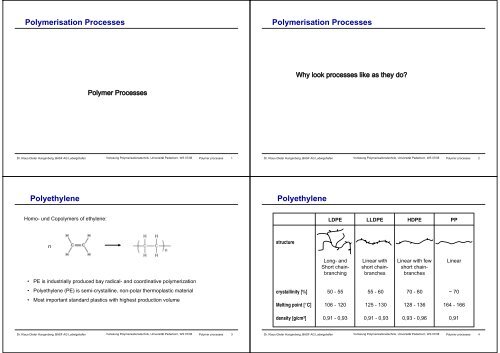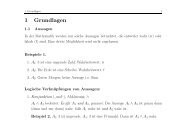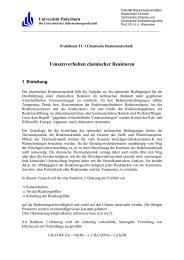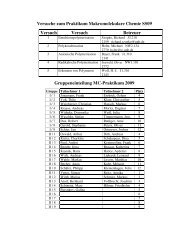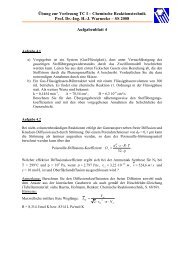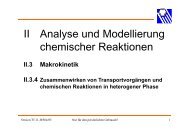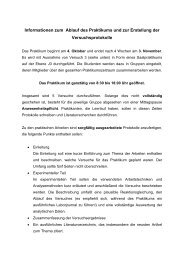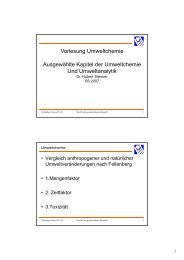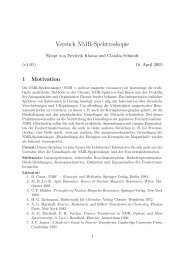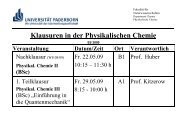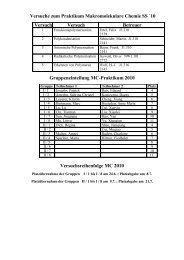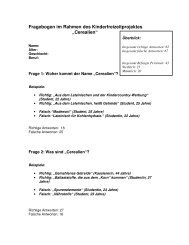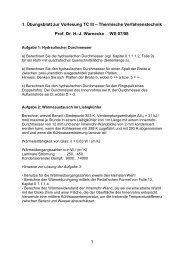Polymerisation Processes Polymerisation Processes Polyethylene ...
Polymerisation Processes Polymerisation Processes Polyethylene ...
Polymerisation Processes Polymerisation Processes Polyethylene ...
Create successful ePaper yourself
Turn your PDF publications into a flip-book with our unique Google optimized e-Paper software.
<strong>Polymerisation</strong> <strong>Processes</strong><br />
Polymer <strong>Processes</strong><br />
Dr. Klaus-Dieter Hungenberg, BASF AG Ludwigshafen Vorlesung <strong>Polymerisation</strong>stechnik, Universität Paderborn, WS 07/08 Polymer processes<br />
<strong>Polyethylene</strong><br />
Homo- und Copolymers of ethylene:<br />
n<br />
• PE is industrially produced bay radical- and coordinative polymerization<br />
• <strong>Polyethylene</strong> (PE) is semi-crystalline, non-polar thermoplastic material<br />
• Most important standard plastics with highest production volume<br />
Dr. Klaus-Dieter Hungenberg, BASF AG Ludwigshafen Vorlesung <strong>Polymerisation</strong>stechnik, Universität Paderborn, WS 07/08 Polymer processes<br />
1<br />
3<br />
<strong>Polymerisation</strong> <strong>Processes</strong><br />
Why look processes like as they do?<br />
Dr. Klaus-Dieter Hungenberg, BASF AG Ludwigshafen Vorlesung <strong>Polymerisation</strong>stechnik, Universität Paderborn, WS 07/08 Polymer processes<br />
<strong>Polyethylene</strong><br />
structure<br />
crystallinity [%]<br />
Melting point [°C]<br />
density [g/cm 3 ]<br />
LDPE LLDPE HDPE PP<br />
Long- and<br />
Short chainbranching<br />
50 - 55<br />
106 - 120<br />
0,91 - 0,93<br />
Linear with<br />
short chainbranches<br />
55 - 60<br />
125 - 130<br />
0,91 - 0,93<br />
Linear with few<br />
short chainbranches<br />
70 - 80<br />
128 - 136<br />
0,93 - 0,96<br />
Linear<br />
Dr. Klaus-Dieter Hungenberg, BASF AG Ludwigshafen Vorlesung <strong>Polymerisation</strong>stechnik, Universität Paderborn, WS 07/08 Polymer processes<br />
~ 70<br />
164 - 166<br />
0,91<br />
2<br />
4
<strong>Polyethylene</strong> applications<br />
• Films<br />
• packaging material<br />
• injection molding<br />
• pipes<br />
• electrical insulation material<br />
Dr. Klaus-Dieter Hungenberg, BASF AG Ludwigshafen Vorlesung <strong>Polymerisation</strong>stechnik, Universität Paderborn, WS 07/08 Polymer processes<br />
<strong>Polyethylene</strong> melt flow index<br />
Melt Flow Rate / Melt Flow Index<br />
= a measure for chain length / molecular weight<br />
Amount of molten polymer [dg/min], that flows at defined conditions (pressure<br />
and temperature) through a defined capillary.<br />
Standards: ASTM 1238 / ISO R1133<br />
weight 2,16 kg / 21,6 kg<br />
temperature 190 °C<br />
geometry capillary:<br />
D=2,095 mm<br />
L=8 mm<br />
High MFR = low molecular weight<br />
Low MFR = high molecular weight<br />
Dr. Klaus-Dieter Hungenberg, BASF AG Ludwigshafen Vorlesung <strong>Polymerisation</strong>stechnik, Universität Paderborn, WS 07/08 Polymer processes<br />
5<br />
7<br />
<strong>Polyethylene</strong> density<br />
Density correlates with crystallinity and structure of PE:<br />
amorphous PE: ρ = 860 kg/m³<br />
crystalline PE: ρ = 1000 kg/m³<br />
Dr. Klaus-Dieter Hungenberg, BASF AG Ludwigshafen Vorlesung <strong>Polymerisation</strong>stechnik, Universität Paderborn, WS 07/08 Polymer processes<br />
Polyethylen <strong>Processes</strong><br />
PE<br />
radical coordinative<br />
homogen homogenous<br />
• bulk<br />
(LDPE high<br />
pressure process)<br />
homogenous heterogenous<br />
• solution • Suspension<br />
(3 Phase „Slurry“<br />
polymerization)<br />
• Gas phase<br />
• bimodal:<br />
slurry-slurry<br />
slurry-GP<br />
GP-GP<br />
Reactions -<br />
mechanism<br />
phases<br />
processes<br />
Dr. Klaus-Dieter Hungenberg, BASF AG Ludwigshafen Vorlesung <strong>Polymerisation</strong>stechnik, Universität Paderborn, WS 07/08 Polymer processes<br />
6<br />
8
High Pressure <strong>Polyethylene</strong> <strong>Processes</strong><br />
High pressure process<br />
in one phase region<br />
low pressure process in<br />
two phase region<br />
Dr. Klaus-Dieter Hungenberg, BASF AG Ludwigshafen Vorlesung <strong>Polymerisation</strong>stechnik, Universität Paderborn, WS 07/08 Polymer processes<br />
R2<br />
Side Reactions inHigh Pressure <strong>Polyethylene</strong><br />
R1<br />
Chain scission – unsaturated chains<br />
R1 CH 2 CH CH 2 R2<br />
Intermolecular transfer to polymer – long chain branching<br />
CH CH 2<br />
2<br />
CH C<br />
2<br />
H2 +<br />
CH CH CH CH 2<br />
2<br />
2<br />
2<br />
CH CH CH R3<br />
2<br />
2<br />
2<br />
R2<br />
R1<br />
CH CH 2<br />
2<br />
CH CH 2<br />
3<br />
Dr. Klaus-Dieter Hungenberg, BASF AG Ludwigshafen Vorlesung <strong>Polymerisation</strong>stechnik, Universität Paderborn, WS 07/08 Polymer processes<br />
+<br />
CH CH C<br />
2<br />
2<br />
CH CH H<br />
2<br />
2<br />
CH 2<br />
n<br />
CH 2<br />
R3<br />
C<br />
H 2<br />
CH 2<br />
R2<br />
H2 C<br />
+<br />
+<br />
R1 CH CH2 R2 H2C<br />
H C CH R2 2 R1 C<br />
C<br />
H 2<br />
H2 C<br />
C<br />
H 2<br />
C<br />
H 2<br />
C<br />
H 2<br />
HC<br />
CH 2<br />
CH 2<br />
C<br />
H 2<br />
H 2<br />
H2 C<br />
R3<br />
9<br />
11<br />
High Pressure <strong>Polyethylene</strong> <strong>Processes</strong><br />
Primary<br />
compressor<br />
Granules<br />
Hyper Compr.<br />
Autoclave<br />
High pressure cycle<br />
150-300 bar<br />
Low pressure<br />
cycle<br />
Extruder<br />
M<br />
alternative<br />
High pressure<br />
separator<br />
Low pressure<br />
separator<br />
T = 200 - 300°C<br />
P = 2000 - 3000 bar<br />
Tubular reactor<br />
Dr. Klaus-Dieter Hungenberg, BASF AG Ludwigshafen Vorlesung <strong>Polymerisation</strong>stechnik, Universität Paderborn, WS 07/08 Polymer processes<br />
Side Reactions inHigh Pressure <strong>Polyethylene</strong><br />
Intramolecular transfer to polymer – short chain branching<br />
R1 CH 2 CH 2 CH<br />
H<br />
CH 2<br />
C<br />
H 2<br />
R1 CH 2 CH 2 CH<br />
R1 CH 2 CH 2 CH<br />
CH 2<br />
CH 2<br />
CH 2<br />
CH H 2<br />
C<br />
H2 CH 2<br />
CH 2<br />
CH 3<br />
C<br />
H 2<br />
CH CH 2 CH 3<br />
CH CH 2 CH 3<br />
R1 CH 2 CH 2 C H<br />
CH 2<br />
n<br />
C<br />
H 2<br />
n<br />
C<br />
H 2<br />
CH 2<br />
Dr. Klaus-Dieter Hungenberg, BASF AG Ludwigshafen Vorlesung <strong>Polymerisation</strong>stechnik, Universität Paderborn, WS 07/08 Polymer processes<br />
CH 2<br />
C<br />
H 3<br />
CH 2<br />
CH 2<br />
CH 2<br />
n<br />
M<br />
C<br />
H 2<br />
CH 2<br />
R1 CH 2 CH 2 CH<br />
CH 2<br />
CH 2<br />
CH 2<br />
CH 3<br />
CH 2 CH 2 CH 2 CH 2 CH 2<br />
R1 CH CH CH CH CH CH CH CH 2 2 2<br />
2 2 2<br />
CH 2<br />
CH 3<br />
CH 2<br />
CH 3<br />
Butyl side groups<br />
Ethyl side groups<br />
10<br />
12
Dr. Klaus-Dieter Hungenberg, BASF AG Ludwigshafen Vorlesung <strong>Polymerisation</strong>stechnik, Universität Paderborn, WS 07/08 Polymer processes<br />
I, M<br />
300<br />
200<br />
100<br />
Activation energy and volumes in LDPE<br />
Different operation modes in LDPE reactors<br />
Single monomer feed of monomer<br />
Multiple initiator possible<br />
Single initiator feed<br />
I<br />
double initiator feed<br />
300<br />
Dr. Klaus-Dieter Hungenberg, BASF AG Ludwigshafen Vorlesung <strong>Polymerisation</strong>stechnik, Universität Paderborn, WS 07/08 Polymer processes<br />
200<br />
100<br />
I, M<br />
Multiple feed of monomer and initiator<br />
I, M<br />
I, M<br />
13<br />
15<br />
Process parameters and properties - Trends<br />
Dr. Klaus-Dieter Hungenberg, BASF AG Ludwigshafen Vorlesung <strong>Polymerisation</strong>stechnik, Universität Paderborn, WS 07/08 Polymer processes<br />
Coordinative <strong>Polyethylene</strong> <strong>Processes</strong><br />
Dr. Klaus-Dieter Hungenberg, BASF AG Ludwigshafen Vorlesung <strong>Polymerisation</strong>stechnik, Universität Paderborn, WS 07/08 Polymer processes<br />
14<br />
16
Solution Coordinative <strong>Polyethylene</strong> <strong>Processes</strong><br />
Solution process:<br />
• broad range of comonomer types and densities possible<br />
• pure products<br />
• limitation: high molecular weight (high temperature, transfer to solvent)<br />
• temperature well above melting point of PE<br />
• commercial processes:<br />
• processes with very short residence time, e.g. 2 min:<br />
• Nova Sclairtech / Advanced Sclairtech<br />
• Sabic / Stamicarbon Compact solution process<br />
• processes with longer residence time e.g. 30 min:<br />
• Dowlex<br />
• Mitsui<br />
Dr. Klaus-Dieter Hungenberg, BASF AG Ludwigshafen Vorlesung <strong>Polymerisation</strong>stechnik, Universität Paderborn, WS 07/08 Polymer processes<br />
Solution Coordinative <strong>Polyethylene</strong> <strong>Processes</strong><br />
Sclairtech Dowlex<br />
temperature 200 - 300 °C 160 °C<br />
pressure bis zu 100 bar 27 bar<br />
solvent cyclohexane C8 / C9 paraffines<br />
Residence time approx. 2 min approx. 30 min<br />
heat removal: convective convective and conductive<br />
Dr. Klaus-Dieter Hungenberg, BASF AG Ludwigshafen Vorlesung <strong>Polymerisation</strong>stechnik, Universität Paderborn, WS 07/08 Polymer processes<br />
17<br />
19<br />
Solution Coordinative <strong>Polyethylene</strong> <strong>Processes</strong><br />
Flowsheet for solution polymerization (DSM)<br />
Ethylen<br />
Comonomer<br />
solvent<br />
Solvent recycle<br />
venting<br />
Additives<br />
Absorber Reactor Flash-Tank<br />
Mixer<br />
Extruder<br />
Additive<br />
solvent Hexane<br />
Temperature 130°C<br />
Residence time ~ 10 min<br />
Solid content < 10 %<br />
adiabatic<br />
High space time yield<br />
Reactor volume 5 m 3 for 5 t HDPE/h<br />
Solvent purification<br />
Flash<br />
-Tank<br />
HDPE-Granules<br />
Dr. Klaus-Dieter Hungenberg, BASF AG Ludwigshafen Vorlesung <strong>Polymerisation</strong>stechnik, Universität Paderborn, WS 07/08 Polymer processes<br />
Slurry Coordinative <strong>Polyethylene</strong> <strong>Processes</strong><br />
Slurry process:<br />
• developed for HDPE<br />
• Limitation: low density, low molecular weight: partial solubility of the polymer<br />
in the suspension media, fouling<br />
• suitable for densities above 930 kg/m³ resp. 920 kg/m³ (with SSC)<br />
• CSTR‘s or slurry-loop reactors used<br />
• suspension media: paraffines, e.g. hexane, isobutane<br />
• many commercial processes:<br />
• processes with loop reactor<br />
• Phillips Loop<br />
• Solvay<br />
• processes with stirred tank reactors<br />
• Hostalen<br />
• Mitsui CX<br />
Dr. Klaus-Dieter Hungenberg, BASF AG Ludwigshafen Vorlesung <strong>Polymerisation</strong>stechnik, Universität Paderborn, WS 07/08 Polymer processes<br />
18<br />
20
Slurry Coordinative– Phillips Loop<br />
Flowsheet of the Phillips Loop process<br />
a) Catalyst hopper and feed valve; b) Double loop reactor; c) Flash tank; d) Purge<br />
drier; e) Powder-fed extruder; f) Impeller; g) Sedimentation leg<br />
Suspension media:<br />
isobutane<br />
T = 85 – 100 C<br />
p = 37 bar<br />
residence time 30 – 60 min<br />
solid content: up to 50 %<br />
high specific surface<br />
reactor completely filled<br />
Dr. Klaus-Dieter Hungenberg, BASF AG Ludwigshafen Vorlesung <strong>Polymerisation</strong>stechnik, Universität Paderborn, WS 07/08 Polymer processes<br />
Polypropylene applications<br />
PP is versatile in application:<br />
• packaging material (flexible films and rigid packings)<br />
• fibers<br />
• injection molding parts for automotive, electrical applications, consumer<br />
electronics<br />
• Chemical equipment, piping<br />
High growth rates for PP<br />
Dr. Klaus-Dieter Hungenberg, BASF AG Ludwigshafen Vorlesung <strong>Polymerisation</strong>stechnik, Universität Paderborn, WS 07/08 Polymer processes<br />
21<br />
23<br />
Fluidized Bed <strong>Polyethylene</strong> <strong>Processes</strong><br />
Fluidized-bed process<br />
a) Catalyst hopper and feed valve; b) Fluidized-bed reactor; c) Cyclone; d) Filter;<br />
e) Polymer take-off system; f) Product recovery cyclone; g) Monomer recovery<br />
compressor; h) Purge hopper; i) Recycle compressor; j) Recycle gas cooler<br />
T=80 – 100° C<br />
P = 7 – 20 bars<br />
RTD comparable to CSTR<br />
Body widening in upper<br />
part of the reactor in order<br />
to reduce gas velocity<br />
Partly condensation<br />
cooling („condensed mode“<br />
Dr. Klaus-Dieter Hungenberg, BASF AG Ludwigshafen Vorlesung <strong>Polymerisation</strong>stechnik, Universität Paderborn, WS 07/08 Polymer processes<br />
Polypropylene structure<br />
Crystallinity correlates with stereo selectivity and melting point<br />
Isotactic = crystalline<br />
Atactic = amorphous<br />
Isotactic PP<br />
misinsertion<br />
syndiotactic PP<br />
atactic PP<br />
Dr. Klaus-Dieter Hungenberg, BASF AG Ludwigshafen Vorlesung <strong>Polymerisation</strong>stechnik, Universität Paderborn, WS 07/08 Polymer processes<br />
22<br />
24
Types of Polypropylene<br />
• homopolymers<br />
• random-copolymers<br />
with ethylene (1-8 wt.-%)<br />
mit 1-butene<br />
terpolymers<br />
• heterophasic copolymers<br />
at least two-stage processes,<br />
in which a second,<br />
elastomeric phase is generated<br />
Dr. Klaus-Dieter Hungenberg, BASF AG Ludwigshafen Vorlesung <strong>Polymerisation</strong>stechnik, Universität Paderborn, WS 07/08 Polymer processes<br />
Spheripol Process<br />
Spheripol process<br />
a) Loop reactors; b) Primary cyclone; c) Copolymer fluidized bed; d) Secondary and copolymer cyclone;<br />
e) Deactivation; f) Purging<br />
1. Stage:<br />
Matrix homopolymer in bulk<br />
in loop-reactors<br />
2. stage:<br />
Impact-Copolymers in gas<br />
phas polymerization<br />
Dr. Klaus-Dieter Hungenberg, BASF AG Ludwigshafen Vorlesung <strong>Polymerisation</strong>stechnik, Universität Paderborn, WS 07/08 Polymer processes<br />
25<br />
27<br />
Polypropylene <strong>Processes</strong> – a variety<br />
Slurry process in hydrocarbon slurry, tank or loop reactors<br />
Novolen gas phase, vertical stirred powder bed<br />
Innovene gas phase, horizontal stirred powder bed<br />
Unipol fluidized bed<br />
Spheripol slurry loop reactors ( + gas phase copolymer)<br />
Mitsui slurry bulk + gas phase<br />
Borstar liquid / scf proyplen (+gas phase copolymer)<br />
MZCR gas phasem, multi zone circulating reactor<br />
Cat, cocat.<br />
C 3 , H 2 ,<br />
1.Reactor<br />
PP homopolymer<br />
slurry<br />
gas<br />
Active<br />
powder<br />
C 3 , C 2 ,<br />
2. Reactor<br />
PP copolymer<br />
gas<br />
Extrusion<br />
Dr. Klaus-Dieter Hungenberg, BASF AG Ludwigshafen Vorlesung <strong>Polymerisation</strong>stechnik, Universität Paderborn, WS 07/08 Polymer processes<br />
BASF/ Novolen Gas Phase Process<br />
BASF gas-phase Novolen process<br />
a) Primary reactor; b) Copolymerizer; c) Compressors; d) Condensers; e) Liquid pump; f)<br />
Filters; g) Primary cyclone; h) Deactivation/purge<br />
Dr. Klaus-Dieter Hungenberg, BASF AG Ludwigshafen Vorlesung <strong>Polymerisation</strong>stechnik, Universität Paderborn, WS 07/08 Polymer processes<br />
26<br />
28
Amoco Gas Phase Process<br />
Amoco – Chisso gas-phase process<br />
a) Horizontal reactor; b) Fluidized-bed deactivation; c) Compressor; d) Condenser;<br />
e) Hold/separator tank<br />
Dr. Klaus-Dieter Hungenberg, BASF AG Ludwigshafen Vorlesung <strong>Polymerisation</strong>stechnik, Universität Paderborn, WS 07/08 Polymer processes<br />
Borstar Process<br />
Dr. Klaus-Dieter Hungenberg, BASF AG Ludwigshafen Vorlesung <strong>Polymerisation</strong>stechnik, Universität Paderborn, WS 07/08 Polymer processes<br />
29<br />
31<br />
Unipol Fludized Bed Gas Phase Process<br />
UCC/Shell – Unipol fluidized-bed process<br />
a) Primary fluidized bed; b) Copolymer fluidized bed; c) Compressors; d) Coolers; e),<br />
f) Discharge cyclones; g) Purge<br />
Dr. Klaus-Dieter Hungenberg, BASF AG Ludwigshafen Vorlesung <strong>Polymerisation</strong>stechnik, Universität Paderborn, WS 07/08 Polymer processes<br />
processes with different reaction zones in one reactor:<br />
M Z C R<br />
RISER<br />
fa st<br />
fluidization<br />
(upw ard<br />
tra n s p o rt)<br />
Catalyst<br />
in le t<br />
Propylene<br />
barrier<br />
stream<br />
DOWNER<br />
packed<br />
bed<br />
(m oving<br />
downward)<br />
Product<br />
discharge<br />
Gas<br />
circulating<br />
com pressor<br />
B A R R IE R S E C TIO N<br />
Condenser<br />
Ethylene<br />
stripping<br />
colum n<br />
Propylene<br />
fe e d<br />
Heat<br />
exchanger<br />
Basell‘s spherizone® Draught tube reactor proposed by<br />
Weickert<br />
Dr. Klaus-Dieter Hungenberg, BASF AG Ludwigshafen Vorlesung <strong>Polymerisation</strong>stechnik, Universität Paderborn, WS 07/08 Polymer processes<br />
30<br />
32
Tailoring of mwd and comonomer distribution<br />
:<br />
• new property combinations<br />
different approaches possible:<br />
• multistage process<br />
• reactors with different reaction zones<br />
• multisite - catalysts<br />
%<br />
Reduced<br />
impact<br />
strength.<br />
Migration,<br />
taste.<br />
Smoke<br />
and odour<br />
during<br />
extrusion<br />
Processability,<br />
stiffness<br />
Matrix<br />
Mechanical<br />
strength<br />
Conventional<br />
ESCR and creep resistance<br />
Melt<br />
strength<br />
during<br />
extrusion<br />
Molecular weight (= polymer chain length)<br />
Dr. Klaus-Dieter Hungenberg, BASF AG Ludwigshafen Vorlesung <strong>Polymerisation</strong>stechnik, Universität Paderborn, WS 07/08 Polymer processes<br />
Bimodal<br />
Controlling mmd by different methods<br />
Aternative processes for<br />
bimodal PP<br />
Dr. Klaus-Dieter Hungenberg, BASF AG Ludwigshafen Vorlesung <strong>Polymerisation</strong>stechnik, Universität Paderborn, WS 07/08 Polymer processes<br />
M<br />
H 2<br />
H 2<br />
t<br />
33<br />
35<br />
Melt flow dependent in mwd<br />
normierte Viskosität η/η o<br />
10 0<br />
-1<br />
10<br />
-2<br />
10<br />
-3<br />
10<br />
melt flow behaviour of different HDPE at 190°C<br />
rel. Häufigkeit<br />
HDPE 3<br />
HDPE 2<br />
HDPE 1<br />
Molmasse<br />
-4<br />
10<br />
-5<br />
10<br />
-3<br />
10<br />
-1<br />
10<br />
Scherrate γ / s<br />
1<br />
10<br />
3<br />
10<br />
-1<br />
Dr. Klaus-Dieter Hungenberg, BASF AG Ludwigshafen Vorlesung <strong>Polymerisation</strong>stechnik, Universität Paderborn, WS 07/08 Polymer processes<br />
Weight %<br />
Controlling mmd by different methods<br />
V<br />
M i<br />
Ti<br />
Dr. Klaus-Dieter Hungenberg, BASF AG Ludwigshafen Vorlesung <strong>Polymerisation</strong>stechnik, Universität Paderborn, WS 07/08 Polymer processes<br />
V<br />
V<br />
V<br />
Ti<br />
Ti<br />
Ti<br />
34<br />
36
Bimodal properties by multi-site catalyst<br />
unimodal process with multi-site catalysts:<br />
• bimodal polymers can be produced with multi-site catalysts in<br />
single stage processes:<br />
Kim, J. D., Soares, J. B. P., Journal of Polymer Science: Part A:<br />
Polymer Chemistry, 38, 1427-1432, (2000)<br />
• lower investment costs compared to multireactor processes /<br />
processes with multizone reactors<br />
• control of polymer structure more difficult / less flexible<br />
• narrower product window compared to multistage processes<br />
Dr. Klaus-Dieter Hungenberg, BASF AG Ludwigshafen Vorlesung <strong>Polymerisation</strong>stechnik, Universität Paderborn, WS 07/08 Polymer processes<br />
Bimodal properties in a reactor cascade<br />
catalyst Cocatalyst<br />
M Propylene<br />
hydrogen<br />
1. Reactor 2. Reactor<br />
M<br />
Silo<br />
Catalyst poison<br />
Propylene<br />
hydrogen<br />
Temperatur[°C]<br />
H 2 -concentration<br />
Dr. Klaus-Dieter Hungenberg, BASF AG Ludwigshafen Vorlesung <strong>Polymerisation</strong>stechnik, Universität Paderborn, WS 07/08 Polymer processes<br />
M w<br />
Catalyst poison<br />
controls fraction in 2.<br />
reactor<br />
37<br />
1. Reactor 2. Reactor<br />
low high<br />
low high<br />
800.000-<br />
1,5 Mio<br />
50.000-<br />
200.000<br />
39<br />
hydrogen response for Ziegler catalysts<br />
Dr. Klaus-Dieter Hungenberg, BASF AG Ludwigshafen Vorlesung <strong>Polymerisation</strong>stechnik, Universität Paderborn, WS 07/08 Polymer processes<br />
Bimodal properties in an oscillating reactor<br />
M<br />
1. Reaktor<br />
Katalysator Cokatalysator<br />
Propylen<br />
Wasserstoff<br />
Dr. Klaus-Dieter Hungenberg, BASF AG Ludwigshafen Vorlesung <strong>Polymerisation</strong>stechnik, Universität Paderborn, WS 07/08 Polymer processes<br />
38<br />
40
Styrenic Polymers<br />
α-MeS<br />
P[S/a-MS]<br />
P[a-MS/AN]<br />
-heat resistant<br />
S/Bu (block-)<br />
copolymers<br />
- tough<br />
- translucent<br />
- low weather<br />
resistance<br />
Bu<br />
PS<br />
- transparent<br />
-stiff<br />
-brittle<br />
MMA<br />
Polybutadienerubber<br />
HIPS<br />
- tough<br />
- opaque<br />
- low weather<br />
resistance<br />
MBS, MABS<br />
- tough<br />
- transparent<br />
Acrylnitril<br />
Polybutadienrubber<br />
ABS<br />
- tough<br />
- opaque<br />
- low weather<br />
resistance<br />
MMA<br />
PSAN<br />
-environmental<br />
stress resistant<br />
Polyacrylaterubber<br />
ASA<br />
- tough<br />
- opaque<br />
- weather<br />
resistance<br />
Dr. Klaus-Dieter Hungenberg, BASF AG Ludwigshafen Vorlesung <strong>Polymerisation</strong>stechnik, Universität Paderborn, WS 07/08 Polymer processes<br />
Styrenic Polymers – processes over the years<br />
IG Farben, 1936 Union Carbide, 1943 Dow, 1952 BASF 1965<br />
Dr. Klaus-Dieter Hungenberg, BASF AG Ludwigshafen Vorlesung <strong>Polymerisation</strong>stechnik, Universität Paderborn, WS 07/08 Polymer processes<br />
41<br />
43<br />
Styrenic Polymers – thermal initiation<br />
*<br />
.<br />
*<br />
+<br />
*<br />
*<br />
* *<br />
H<br />
+<br />
H<br />
*<br />
CH3 * CH<br />
Pn*<br />
Dr. Klaus-Dieter Hungenberg, BASF AG Ludwigshafen Vorlesung <strong>Polymerisation</strong>stechnik, Universität Paderborn, WS 07/08 Polymer processes<br />
Styrenic Polymers –process and mwd<br />
* *<br />
dm<br />
10<br />
dP<br />
-2<br />
Dr. Klaus-Dieter Hungenberg, BASF AG Ludwigshafen Vorlesung <strong>Polymerisation</strong>stechnik, Universität Paderborn, WS 07/08 Polymer processes<br />
+ Pn<br />
Styrene / EB<br />
50-80% conv.<br />
130-170°C<br />
2000 4000 6000 8000<br />
42<br />
44
Degassing polymer solutions / melts<br />
Heat<br />
exchanger<br />
Vacuum<br />
Falling strand devolatiizer<br />
Vacuum<br />
Extruder<br />
Falling strangs<br />
Long diffusion<br />
Adiabatic flash<br />
Renewal of melt surface<br />
Short diffusion paths<br />
Nearly isothermal flash<br />
Vacuum<br />
Vacuum<br />
´tubular / pipe degassing<br />
Separation melt/gas<br />
in tubes<br />
Heating during evaporation<br />
Non-isothermal flash<br />
Thin film evaporator<br />
Extremely thin films<br />
Short diffusion ways<br />
Heating during evaporation<br />
Nearly isothermal flash<br />
Dr. Klaus-Dieter Hungenberg, BASF AG Ludwigshafen Vorlesung <strong>Polymerisation</strong>stechnik, Universität Paderborn, WS 07/08 Polymer processes<br />
Brittle and tough materials<br />
Pure thermoplastic polymer, T g >T use<br />
brittle, hard tough, hard<br />
stress, strain, σ<br />
Area= energy<br />
elongation, ε<br />
Thermoplastic polymer + rubber, T g
HIPS, solution/mass ABS - principles<br />
Rubber ( PBu) dissolved in Styrene<br />
(/ Ethyl benzene)<br />
Polymerization of styrene, homo-PS<br />
and grafted PBu<br />
Phase separation ( PBu/S and PS/S)<br />
Phase inversion<br />
Particle formation<br />
End of reaction<br />
A<br />
B<br />
D<br />
C<br />
Course of reaction<br />
Dr. Klaus-Dieter Hungenberg, BASF AG Ludwigshafen Vorlesung <strong>Polymerisation</strong>stechnik, Universität Paderborn, WS 07/08 Polymer processes<br />
HIPS – phase inversion in first 2 reactors<br />
Viscosity<br />
Reactor 1 Reactor 2<br />
in out in out<br />
Homogene<br />
Lösung<br />
Polybutadiene in styrene<br />
Polystyrene in styrene<br />
conversion<br />
Phase inversion when<br />
volume ratio = 1:1 of<br />
disperse : continuous phase<br />
Stabilization of particles by<br />
graft polymers formed in 1. reactor<br />
Dr. Klaus-Dieter Hungenberg, BASF AG Ludwigshafen Vorlesung <strong>Polymerisation</strong>stechnik, Universität Paderborn, WS 07/08 Polymer processes<br />
49<br />
51<br />
HIPS grafting and phase inversion<br />
PBu in S PS in S<br />
S S<br />
Phase separation Phase inversion<br />
S<br />
B<br />
B<br />
B<br />
B<br />
S S<br />
S S<br />
B<br />
B<br />
B<br />
S B B<br />
S<br />
S<br />
Graft copolymers needed for<br />
stabilization of morphology<br />
S<br />
B<br />
B<br />
B<br />
B<br />
B<br />
S<br />
S<br />
S<br />
S<br />
B<br />
BS<br />
B<br />
B B<br />
S<br />
S<br />
S<br />
Dr. Klaus-Dieter Hungenberg, BASF AG Ludwigshafen Vorlesung <strong>Polymerisation</strong>stechnik, Universität Paderborn, WS 07/08 Polymer processes<br />
HIPS – phase inversion in first 2 reactors<br />
Viscosity<br />
Conversion<br />
Dr. Klaus-Dieter Hungenberg, BASF AG Ludwigshafen Vorlesung <strong>Polymerisation</strong>stechnik, Universität Paderborn, WS 07/08 Polymer processes<br />
S<br />
50<br />
52
HIPS – various continuous processes<br />
Dr. Klaus-Dieter Hungenberg, BASF AG Ludwigshafen Vorlesung <strong>Polymerisation</strong>stechnik, Universität Paderborn, WS 07/08 Polymer processes<br />
Specific heat removal capacity for different reactors<br />
1 – SMR, 2- static mixers, 3- empty tube, 4 – stirred tank, 5 extruder<br />
Dr. Klaus-Dieter Hungenberg, BASF AG Ludwigshafen Vorlesung <strong>Polymerisation</strong>stechnik, Universität Paderborn, WS 07/08 Polymer processes<br />
53<br />
55<br />
HIPS – process with static mixers<br />
solvent<br />
monomer<br />
comonomer<br />
additives<br />
Recycle solvent<br />
water<br />
additives<br />
water<br />
Dr. Klaus-Dieter Hungenberg, BASF AG Ludwigshafen Vorlesung <strong>Polymerisation</strong>stechnik, Universität Paderborn, WS 07/08 Polymer processes<br />
SAN copolymers<br />
Dr. Klaus-Dieter Hungenberg, BASF AG Ludwigshafen Vorlesung <strong>Polymerisation</strong>stechnik, Universität Paderborn, WS 07/08 Polymer processes<br />
54<br />
56
SAN copolymerization behaviour<br />
X_Styrol<br />
1.0<br />
0.8<br />
0.6<br />
0.4<br />
0.2<br />
0.0<br />
Copolymerisationsdiagramm für<br />
Styrol / Acrylnitril<br />
0 0.2 0.4 0.6 0.8 1<br />
x_Styrol<br />
r S=0.34<br />
r AN=0.05<br />
Dr. Klaus-Dieter Hungenberg, BASF AG Ludwigshafen Vorlesung <strong>Polymerisation</strong>stechnik, Universität Paderborn, WS 07/08 Polymer processes<br />
SAN copolymers in CSTR<br />
To flare<br />
SAN,<br />
EB<br />
Multiple degassing unit:<br />
toxic AN<br />
high temperatures give<br />
yellow polymer<br />
W-% AN in polymer<br />
SAN-melt<br />
To Extruder<br />
65% AN<br />
30% AN<br />
24% AN<br />
conversion<br />
10% AN<br />
Dr. Klaus-Dieter Hungenberg, BASF AG Ludwigshafen Vorlesung <strong>Polymerisation</strong>stechnik, Universität Paderborn, WS 07/08 Polymer processes<br />
M<br />
PRC<br />
continous<br />
SAN-<strong>Polymerisation</strong><br />
degassing<br />
SAN-Granulat<br />
57<br />
59<br />
SAN copolymers by….<br />
Suspension polymerization<br />
only azeotropic composition<br />
water- solubility of AN<br />
Emulsion polymerzation<br />
semi- batch, starved feed<br />
shows some haze<br />
Continuous solution polymerization in CSTR<br />
all compositions available<br />
Dr. Klaus-Dieter Hungenberg, BASF AG Ludwigshafen Vorlesung <strong>Polymerisation</strong>stechnik, Universität Paderborn, WS 07/08 Polymer processes<br />
Rubber modification of SAN –> ABS<br />
rubber from emulsion or solution process<br />
Emulsion polymerization<br />
•High glance of surface<br />
•Yellowish colour<br />
•waste water<br />
•Separate polymerization of SAN<br />
(solution polymerization) and rubber<br />
(in emulsion)<br />
1µm<br />
Solution polymerisation<br />
Mat surface<br />
White<br />
No waste water<br />
Solution polymerization of SAN in the<br />
presence of rubber as for HIPS<br />
Dr. Klaus-Dieter Hungenberg, BASF AG Ludwigshafen Vorlesung <strong>Polymerisation</strong>stechnik, Universität Paderborn, WS 07/08 Polymer processes<br />
1µm<br />
58<br />
60
Emulsion Rubbers for impact modification of SAN<br />
100-250nm<br />
Product<br />
Rubber type<br />
Double bonds<br />
T g<br />
Weather resistance<br />
Low temperature impact resistance<br />
SAN matrix<br />
Crosslinked<br />
rubber<br />
SAN graft<br />
ABS<br />
Polybutadiene<br />
Many<br />
-80°C<br />
-<br />
high<br />
ASA<br />
Acrylic ester+ bifunctional<br />
monomer<br />
-<br />
-40°C<br />
High<br />
low<br />
Dr. Klaus-Dieter Hungenberg, BASF AG Ludwigshafen Vorlesung <strong>Polymerisation</strong>stechnik, Universität Paderborn, WS 07/08 Polymer processes<br />
PMMA – Polymethyl methacrylate<br />
Some special features<br />
Strong gel effect<br />
Low ceiling temperature<br />
Tendency to depolymerization<br />
High shrinkage<br />
Termination by combination and disproportionation<br />
Dr. Klaus-Dieter Hungenberg, BASF AG Ludwigshafen Vorlesung <strong>Polymerisation</strong>stechnik, Universität Paderborn, WS 07/08 Polymer processes<br />
61<br />
63<br />
ABS, ASA via emulsion rubber and solution SAN<br />
SAN-melt<br />
Dr. Klaus-Dieter Hungenberg, BASF AG Ludwigshafen Vorlesung <strong>Polymerisation</strong>stechnik, Universität Paderborn, WS 07/08 Polymer processes<br />
PRCS<br />
M<br />
vapor<br />
PMMA – gel an glass effect effect<br />
M<br />
PRC<br />
conversion<br />
M<br />
M<br />
M<br />
M M M M<br />
Due to<br />
glass effect<br />
M<br />
Vacuum<br />
Base rubber<br />
SAN grafting<br />
Storage tank<br />
precipitation<br />
De-watering<br />
extruder<br />
Dr. Klaus-Dieter Hungenberg, BASF AG Ludwigshafen Vorlesung <strong>Polymerisation</strong>stechnik, Universität Paderborn, WS 07/08 Polymer processes<br />
ABS<br />
Due to<br />
Ceiling temperature<br />
50 100 150 200<br />
100%<br />
T/°C<br />
62<br />
64
PMMA – weak links<br />
From combination<br />
O<br />
O O<br />
O<br />
O<br />
O<br />
From disproportionation<br />
Comonomers stop unzipping<br />
O<br />
O<br />
Dr. Klaus-Dieter Hungenberg, BASF AG Ludwigshafen Vorlesung <strong>Polymerisation</strong>stechnik, Universität Paderborn, WS 07/08 Polymer processes<br />
2<br />
C*<br />
O<br />
CH 3<br />
O<br />
+ CH2 *<br />
C*<br />
O<br />
CH 3<br />
O<br />
O<br />
Starting point for depolymerization<br />
MMMMMMMMMMMMMMMMMXMMMMMM* MMMMMMMMMMMMMMMMMX* + M<br />
PMMA – process for plates and sheets<br />
Dr. Klaus-Dieter Hungenberg, BASF AG Ludwigshafen Vorlesung <strong>Polymerisation</strong>stechnik, Universität Paderborn, WS 07/08 Polymer processes<br />
O<br />
65<br />
67<br />
PMMA – continuous bulk process<br />
Dr. Klaus-Dieter Hungenberg, BASF AG Ludwigshafen Vorlesung <strong>Polymerisation</strong>stechnik, Universität Paderborn, WS 07/08 Polymer processes<br />
PVC – suspension process<br />
⎛ ⎞<br />
1 ln⎜ p<br />
⎟ = ln( 1−<br />
Φ<br />
0<br />
2)<br />
+ Φ2<br />
+ χΦ<br />
⎜ ⎟<br />
⎝ p1<br />
⎠<br />
χ=0.98<br />
s = kH<br />
2<br />
2<br />
p<br />
0<br />
p<br />
p=const- =<br />
separate monomer phase<br />
Dr. Klaus-Dieter Hungenberg, BASF AG Ludwigshafen Vorlesung <strong>Polymerisation</strong>stechnik, Universität Paderborn, WS 07/08 Polymer processes<br />
66<br />
68
PVC – suspension process<br />
Dr. Klaus-Dieter Hungenberg, BASF AG Ludwigshafen Vorlesung <strong>Polymerisation</strong>stechnik, Universität Paderborn, WS 07/08 Polymer processes<br />
PVC – bulk process, post reactors<br />
High solid<br />
Particle size 0.08-0.2 mm<br />
Dr. Klaus-Dieter Hungenberg, BASF AG Ludwigshafen Vorlesung <strong>Polymerisation</strong>stechnik, Universität Paderborn, WS 07/08 Polymer processes<br />
69<br />
71<br />
PVC – bulk process<br />
Prepolymerization up to 10%<br />
Post polymerization up to 85-90%<br />
Dr. Klaus-Dieter Hungenberg, BASF AG Ludwigshafen Vorlesung <strong>Polymerisation</strong>stechnik, Universität Paderborn, WS 07/08 Polymer processes<br />
PVC – bulk process, particle size and stirring<br />
Dr. Klaus-Dieter Hungenberg, BASF AG Ludwigshafen Vorlesung <strong>Polymerisation</strong>stechnik, Universität Paderborn, WS 07/08 Polymer processes<br />
70<br />
72
The Nylon revolution 1945<br />
O O<br />
N (CH2 ) N 6 C (CH2 ) C 6 n<br />
H H<br />
Dr. Klaus-Dieter Hungenberg, BASF AG Ludwigshafen Vorlesung <strong>Polymerisation</strong>stechnik, Universität Paderborn, WS 07/08 Polymer processes<br />
Polyamides – base materials<br />
ε-Caprolactam: OH<br />
+6H<br />
(Ni)<br />
OH<br />
H<br />
-2H<br />
O<br />
+H2NOH -H2O N H<br />
Phenol Cyclohexanol Cyclohexanon Cyclohexanon-oxim<br />
Hexamethylene diamine:<br />
Adipic acid:<br />
+6H<br />
(Ni)<br />
Benzene Cyclohexan<br />
H 2C = CH – CH = CH 2<br />
H2C – CH = CH – CH2 CN CN<br />
+CINO<br />
- HCI<br />
(H 2 SO 4 )<br />
H2 C<br />
H2C CO<br />
H2C NH<br />
H2C CH2 ε-Caprolactam:<br />
Dr. Klaus-Dieter Hungenberg, BASF AG Ludwigshafen Vorlesung <strong>Polymerisation</strong>stechnik, Universität Paderborn, WS 07/08 Polymer processes<br />
+Cl 2<br />
+2H<br />
(Ni)<br />
+2NaCN<br />
H2C = CH – CH = CH2 -2NaCl<br />
Cl Cl<br />
NC – (CH2) 4 –CN<br />
+8H<br />
(Ni, NH3 )<br />
H2N – (CH2) 6 –NH2 Adiponitrile Hexamethylendiamin<br />
H2C H2C CH2 C<br />
H2C CH2 H<br />
OH<br />
H2C H2C CH2 C = O<br />
COOH<br />
(CH2 ) 4<br />
H2C CH2 COOH<br />
Cyclohexanol Cyclohexanone Adipic acid<br />
73<br />
75<br />
Polyamides – basic structures<br />
PA 6: Perlon PA6.6: Nylon<br />
O<br />
NH ( CH ) 2 C<br />
NH ( NH<br />
5<br />
CH ) 2 C (<br />
6 CH ) 2 C<br />
4<br />
n<br />
n<br />
PA 6: Caprolactam<br />
PA 11: Undecanlactam<br />
PA 12: Laurinlactam<br />
PA 6.6: Hexamethylendiamine<br />
+ Adipic acid<br />
PA 6.10: Hexamethylendiamien<br />
+ Sebacic acid<br />
PA 4.6: Butandiamine<br />
+ Adipic acid<br />
Dr. Klaus-Dieter Hungenberg, BASF AG Ludwigshafen Vorlesung <strong>Polymerisation</strong>stechnik, Universität Paderborn, WS 07/08 Polymer processes<br />
PA6 – basic reactions<br />
1. Ring opening<br />
NH (CH2 ) CO + H 5 2O H NH (CH2 ) COOH<br />
5<br />
2. Polyaddition<br />
NH (CH2 ) CO + H NH (CH CO OH<br />
5<br />
2 ) 5<br />
3. Polycondensation<br />
n<br />
Dr. Klaus-Dieter Hungenberg, BASF AG Ludwigshafen Vorlesung <strong>Polymerisation</strong>stechnik, Universität Paderborn, WS 07/08 Polymer processes<br />
O<br />
H NH (CH2 ) CO OH<br />
5<br />
H NH (CH2 ) CO OH + H NH (CH CO OH H NH CO OH + H2O 5 2 ) (CH 5 2 ) 5<br />
n<br />
m<br />
n+1<br />
n+m<br />
O<br />
74<br />
76
Polyamide 6 - VK column<br />
water<br />
ε-Caprolactame<br />
melting<br />
80°C<br />
preparation<br />
Melt filter<br />
Pre condensation<br />
250°C, 40 bar<br />
Mean residence time VK column ≈ 15 - 30 h<br />
throughput:<br />
≈ 2000 moto<br />
Dr. Klaus-Dieter Hungenberg, BASF AG Ludwigshafen Vorlesung <strong>Polymerisation</strong>stechnik, Universität Paderborn, WS 07/08 Polymer processes<br />
M<br />
VK-column<br />
270°C<br />
280°C<br />
Water<br />
granulation<br />
Extractor<br />
95°C<br />
silo<br />
dryer 80°C<br />
PA6-process – modelling of melt process<br />
Model input:<br />
Kinetic scheme and<br />
parameters<br />
Non-ideal phase behavior<br />
using NRTL model<br />
Model output:<br />
Molecular weight<br />
end groups<br />
Residual monomer<br />
Oligomer concentration<br />
Granules<br />
Vacuum<br />
(1 mbar)<br />
Dr. Klaus-Dieter Hungenberg, BASF AG Ludwigshafen Vorlesung <strong>Polymerisation</strong>stechnik, Universität Paderborn, WS 07/08 Polymer processes<br />
180<br />
160<br />
140<br />
120<br />
100<br />
80<br />
60<br />
40<br />
20<br />
simulation results taking into account exp. binary VLE date<br />
Extract, %, CL, H2O, Oligomers<br />
NH2-end groups<br />
degree of polymerization<br />
dimer, %<br />
0<br />
0<br />
235 240 245 250 255 260 265 270 275 280<br />
temperature in top of VK-Rohr<br />
1<br />
0.9<br />
0.8<br />
0.7<br />
0.6<br />
0.5<br />
0.4<br />
0.3<br />
0.2<br />
0.1<br />
77<br />
79<br />
PA6-process – modelling of each process unit<br />
Melt polymerization<br />
Schmelzepolymerisation im VK - Rohr Extraction Extraktion of oligomers Trocknung/Temperung<br />
Drying,<br />
N 2<br />
Caprolactam<br />
(+Kettenregler) (+chain regulator + 0,5% + H2O) H 2O Bedingungen:<br />
τ : 9 - 17 h<br />
T : 250 - 280 °C<br />
p : 0 - 0,3 bar<br />
PA 6 - Granules<br />
Extracttwater<br />
Bedingungen:<br />
τ : 17 - 30 h<br />
T : 95 - 120 °C<br />
Water<br />
solid state polymerization<br />
N2 -O2 Granulation<br />
air<br />
Polyamide 6<br />
Dr. Klaus-Dieter Hungenberg, BASF AG Ludwigshafen Vorlesung <strong>Polymerisation</strong>stechnik, Universität Paderborn, WS 07/08 Polymer processes<br />
PA6-process – modelling of extraction<br />
Model assumptions:<br />
Nernst law at phase<br />
boundaries<br />
Nernst coefficient dependent<br />
on monomer concentration<br />
Fick diffusion in polymer<br />
phase and liquid boundary<br />
layer<br />
Model output:<br />
Concentration profile of<br />
residual monomer and<br />
oligomer in polymer and<br />
liquid phase<br />
-H 2 O<br />
Bedingungen:<br />
τ : 20 - 40 h<br />
T : 135 - 180 °C<br />
nitorgen<br />
Top2 4 6 8 10 bottom 12<br />
Dr. Klaus-Dieter Hungenberg, BASF AG Ludwigshafen Vorlesung <strong>Polymerisation</strong>stechnik, Universität Paderborn, WS 07/08 Polymer processes<br />
10<br />
8<br />
6<br />
4<br />
2<br />
1<br />
0.8<br />
0.6<br />
0.4<br />
0.2<br />
% extractable<br />
% dimer in granules<br />
Top 2 4 6 8 10 12 bottom<br />
78<br />
80
PA6-process – modelling of solid state condensation<br />
Model assumptions:<br />
Polymer end groups, water,<br />
monomer und oligomere only in<br />
amorphous phase<br />
reaction kinetics as in melt<br />
diffusion coefficients dependent on<br />
degree of crystallinity<br />
surface is free of water<br />
Isothermal spherical particle<br />
Model output<br />
Pn, monomer and oligomer<br />
concentration<br />
0 10 20 30 40 50<br />
reaction tim e [h]<br />
Dr. Klaus-Dieter Hungenberg, BASF AG Ludwigshafen Vorlesung <strong>Polymerisation</strong>stechnik, Universität Paderborn, WS 07/08 Polymer processes<br />
Polyamide 66 - tank process<br />
mass fraction of caprolactam [%]<br />
number-average chain length<br />
0.20<br />
0.18<br />
0.16<br />
0.14<br />
0.12<br />
0.10<br />
0.08<br />
0.06<br />
0.04<br />
0.02<br />
0.00<br />
450<br />
400<br />
350<br />
300<br />
250<br />
200<br />
150<br />
100<br />
0 10 20 30 40 50<br />
T = 125°C<br />
T = 145°C<br />
T = 165°C<br />
T = 180°C<br />
T = 190°C<br />
model<br />
reaction tim e [h]<br />
T = 145°C<br />
T = 165°C<br />
T = 190°C<br />
model<br />
Dr. Klaus-Dieter Hungenberg, BASF AG Ludwigshafen Vorlesung <strong>Polymerisation</strong>stechnik, Universität Paderborn, WS 07/08 Polymer processes<br />
81<br />
83<br />
PA66- basic reactions<br />
O O<br />
HO C (CH2 ) C<br />
4<br />
OH<br />
Adipic acid Hexamethylene diamine<br />
–H 2 O<br />
Dr. Klaus-Dieter Hungenberg, BASF AG Ludwigshafen Vorlesung <strong>Polymerisation</strong>stechnik, Universität Paderborn, WS 07/08 Polymer processes<br />
+<br />
+ H 2 O<br />
AH-salt solution<br />
Polycondensation<br />
O O<br />
HO C (CH2 ) C<br />
4<br />
NH<br />
NH<br />
(CH 2 ) 6<br />
H2N (CH CH2<br />
) NH<br />
6 2<br />
Polyamide 66 – continous tubular process<br />
H 2 O-Steam<br />
tube reactor<br />
Pump<br />
Separator<br />
40-60%<br />
AH-Salt Solution<br />
Devolatilisation<br />
e.g. Extruder<br />
Dr. Klaus-Dieter Hungenberg, BASF AG Ludwigshafen Vorlesung <strong>Polymerisation</strong>stechnik, Universität Paderborn, WS 07/08 Polymer processes<br />
H<br />
Pump<br />
Polymer<br />
Melt<br />
Postcondensation<br />
82<br />
High energy consumption<br />
Evt. loss of volatiles in<br />
vapor<br />
84
Polyamide 66 – countercurrent process – reactive<br />
distillation<br />
Reactive<br />
distillation<br />
Temperature<br />
conventional<br />
Molten diacid<br />
feed (bb)<br />
Steam<br />
Pressure<br />
atmospheric<br />
typically<br />
Gaseous diamine<br />
feed (aa)<br />
Polymer<br />
(aabb)<br />
Product Mn<br />
9000<br />
typically<br />
Dr. Klaus-Dieter Hungenberg, BASF AG Ludwigshafen Vorlesung <strong>Polymerisation</strong>stechnik, Universität Paderborn, WS 07/08 Polymer processes<br />
Some processes – PET, PBT from DMT<br />
O O<br />
CH3 O C C O CH3 Dr. Klaus-Dieter Hungenberg, BASF AG Ludwigshafen Vorlesung <strong>Polymerisation</strong>stechnik, Universität Paderborn, WS 07/08 Polymer processes<br />
85<br />
87<br />
Polyethylen(butylen)terephtalat, PET, PBT<br />
O O<br />
O O<br />
CH3 O C C O CH3HO (CH2 ) OH<br />
x<br />
HO C C OH<br />
Terephtalic acid ester Diol Terephtalic acid<br />
transesterification esterfication<br />
O O<br />
HO (CH2 ) O<br />
x<br />
C C O (CH2 ) OH<br />
x<br />
Pre-condensation<br />
Post-condensation<br />
O O<br />
HO C C O (CH2 ) O H<br />
x<br />
x=2: PET<br />
x=4: PBT<br />
Side reactions: acetaldehyde, THF from butane diol (PBT)<br />
Dr. Klaus-Dieter Hungenberg, BASF AG Ludwigshafen Vorlesung <strong>Polymerisation</strong>stechnik, Universität Paderborn, WS 07/08 Polymer processes<br />
Rotating disc reactor for PET, PBT<br />
n<br />
To force conversion from 0.95 to 0.99 –<br />
0.995 ( or P n >100), water removal more<br />
important than for polyamides, because<br />
of low equilibrium constants<br />
Dr. Klaus-Dieter Hungenberg, BASF AG Ludwigshafen Vorlesung <strong>Polymerisation</strong>stechnik, Universität Paderborn, WS 07/08 Polymer processes<br />
86<br />
88
Polyoxymethylene – anionic polymerization of CH 2 O<br />
CH 2 O<br />
Purification, drying<br />
CH 2 O<br />
R Hexane<br />
Suspensions polymerization<br />
Formaldehyde<br />
(water solution.)<br />
Formaldehyde<br />
(Gas)<br />
R O CH2 O CH2O n<br />
Acetic anhydride<br />
End group stabilization by chemical modification<br />
R O CH2 O CH2O O CH<br />
n<br />
3<br />
Dr. Klaus-Dieter Hungenberg, BASF AG Ludwigshafen Vorlesung <strong>Polymerisation</strong>stechnik, Universität Paderborn, WS 07/08 Polymer processes<br />
Polyoxymethylene – end group stabilization<br />
Dr. Klaus-Dieter Hungenberg, BASF AG Ludwigshafen Vorlesung <strong>Polymerisation</strong>stechnik, Universität Paderborn, WS 07/08 Polymer processes<br />
O<br />
89<br />
91<br />
Polyoxymethylene – anionic polymerization of CH 2 O<br />
Dr. Klaus-Dieter Hungenberg, BASF AG Ludwigshafen Vorlesung <strong>Polymerisation</strong>stechnik, Universität Paderborn, WS 07/08 Polymer processes<br />
Polyoxymethylene – cationic bulk process –<br />
‘Schalenkreis’<br />
Milling<br />
Vacuum<br />
Heat Stabilizier<br />
Antioxidant<br />
Polymerized<br />
Material<br />
Additives<br />
Dr. Klaus-Dieter Hungenberg, BASF AG Ludwigshafen Vorlesung <strong>Polymerisation</strong>stechnik, Universität Paderborn, WS 07/08 Polymer processes<br />
90<br />
92
Polyoxymethylene – cationic kneader process<br />
Dr. Klaus-Dieter Hungenberg, BASF AG Ludwigshafen Vorlesung <strong>Polymerisation</strong>stechnik, Universität Paderborn, WS 07/08 Polymer processes<br />
93


